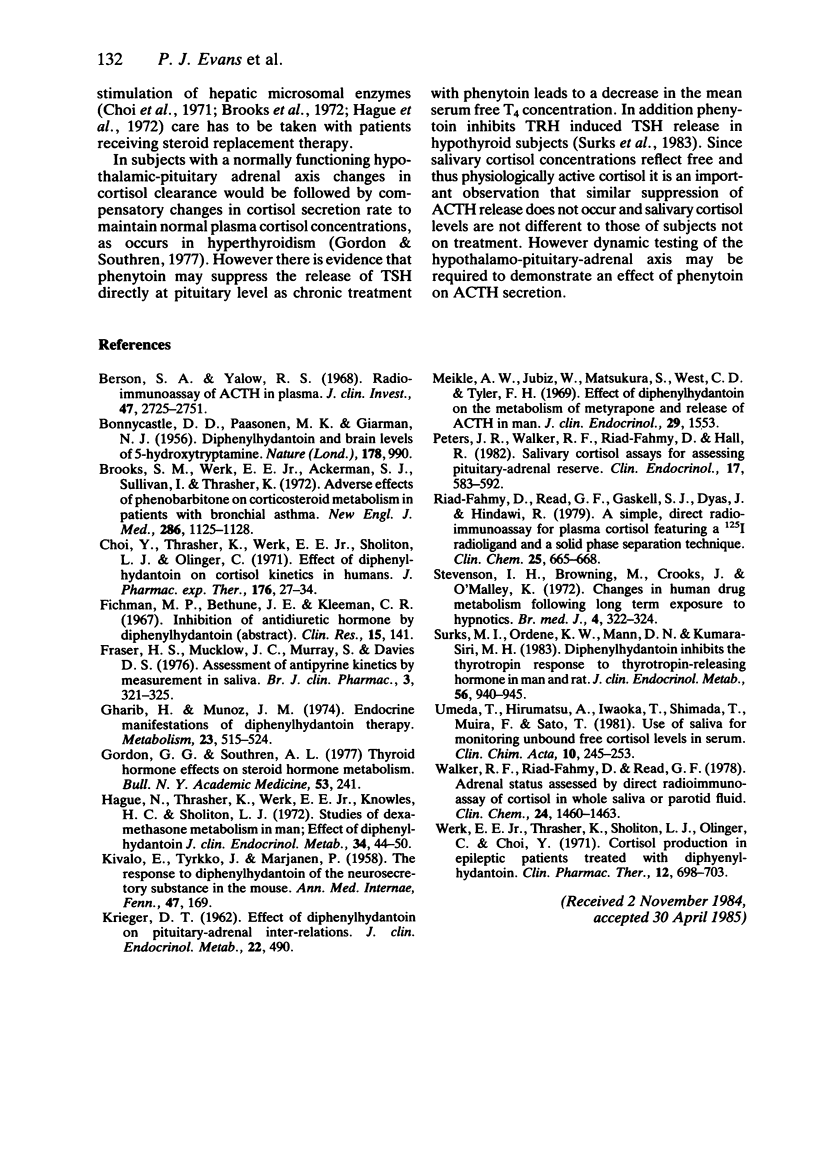Abstract
The effect of anticonvulsant therapy on early morning concentration of cortisol in saliva and plasma was assessed in a group of epileptic patients receiving regular phenytoin medication and the results compared with those obtained from a group of normal subjects not receiving drug therapy. Values of cortisol in matched samples of plasma (331 +/- 23 nmol l-1, mean +/- s.e. mean, n = 6) and saliva (11.4 +/- 0.9 nmol l-1, mean +/- s.e. mean, n = 9) provided by epileptics did not differ significantly from those in the plasma (334 +/- 41 nmol l-1, mean +/- s.e. mean) and saliva (12.0 +/- 2.0 nmol-1, mean +/- s.e. mean) of healthy volunteers (n = 12). Six anticonvulsant-treated epileptics, together with six age and sex matched normal volunteers, each received intravenous dexamethasone (1 mg h-1) to determine the half-life of cortisol in plasma and saliva. In the anticonvulsant-treated group, the half-life of cortisol in plasma (73 +/- 5 min, mean +/- s.e. mean) and saliva (83 +/- 5 min, mean +/- s.e. mean) was reduced significantly (P less than 0.01 plasma, P less than 0.05 saliva) from that observed in healthy volunteers. In patients, the half life of cortisol and antipyrine showed a significant correlation (r2 = 0.75, P less than 0.05 plasma, r2 = 0.71, P less than 0.05 saliva). The antipyrine half-life in saliva was reduced significantly (P less than 0.02) and the antipyrine clearance rate, increased significantly (P less than 0.005) in the treated epileptic group, reflecting drug-induced microsomal enzyme production.(ABSTRACT TRUNCATED AT 250 WORDS)
Full text
PDF



Selected References
These references are in PubMed. This may not be the complete list of references from this article.
- BONNYCASTLE D. D., GIARMAN N. J., PAASONEN M. K. Diphenylhydantoin and brain-levels and 5-hydroxytryptamine. Nature. 1956 Nov 3;178(4540):990–991. doi: 10.1038/178990a0. [DOI] [PubMed] [Google Scholar]
- Berson S. A., Yalow R. S. Radioimmunoassay of ACTH in plasma. J Clin Invest. 1968 Dec;47(12):2725–2751. doi: 10.1172/JCI105955. [DOI] [PMC free article] [PubMed] [Google Scholar]
- Brooks S. M., Werk E. E., Ackerman S. J., Sullivan I., Thrasher K. Adverse effects of phenobarbital on corticosteroid metabolism in patients with bronchial asthma. N Engl J Med. 1972 May 25;286(21):1125–1128. doi: 10.1056/NEJM197205252862103. [DOI] [PubMed] [Google Scholar]
- Choi Y., Thrasher K., Werk E. E., Jr, Sholiton L. J., Olinger C. Effect of diphenylhydantoin on cortisol kinetics in humans. J Pharmacol Exp Ther. 1971 Jan;176(1):27–34. [PubMed] [Google Scholar]
- Fraser H. S., Mucklow J. C., Murray S., Davies D. S. Assessment of antipyrine kinetics by measurement in saliva. Br J Clin Pharmacol. 1976 Apr;3(2):321–325. doi: 10.1111/j.1365-2125.1976.tb00610.x. [DOI] [PMC free article] [PubMed] [Google Scholar]
- Gharib H., Munoz J. M. Endocrine manifestations of diphenylhydantoin therapy. Metabolism. 1974 Jun;23(6):515–524. doi: 10.1016/0026-0495(74)90079-1. [DOI] [PubMed] [Google Scholar]
- Gordon G. G., Southren A. L. Thyroid - hormone effects on steroid - hormone metabolism. Bull N Y Acad Med. 1977 Apr;53(3):241–259. [PMC free article] [PubMed] [Google Scholar]
- Haque N., Thrasher K., Werk E. E., Jr, Knowles H. C., Jr, Sholiton L. J. Studies on dexamethasone metabolism in man: effect of diphenylhydantoin. J Clin Endocrinol Metab. 1972 Jan;34(1):44–50. doi: 10.1210/jcem-34-1-44. [DOI] [PubMed] [Google Scholar]
- KIVALO E., TYRKKO J., MARJANEN P. The response to diphenylhydantoin of the neurosecretory substance in the mouse. Ann Med Intern Fenn. 1958;47(3):169–173. [PubMed] [Google Scholar]
- KRIEGER D. T. Effect of diphenylhydantoin on pituitary-adrenal interrelations. J Clin Endocrinol Metab. 1962 May;22:490–493. doi: 10.1210/jcem-22-5-490. [DOI] [PubMed] [Google Scholar]
- Meikle A. W., Jubiz W., Matsukura S., West C. D., Tyler F. H. Effect of diphenylhydantoin on the metabolism of metyrapone and release of ACTH in man. J Clin Endocrinol Metab. 1969 Dec;29(12):1553–1558. doi: 10.1210/jcem-29-12-1553. [DOI] [PubMed] [Google Scholar]
- Peters J. R., Walker R. F., Riad-Fahmy D., Hall R. Salivary cortisol assays for assessing pituitary-adrenal reserve. Clin Endocrinol (Oxf) 1982 Dec;17(6):583–592. doi: 10.1111/j.1365-2265.1982.tb01631.x. [DOI] [PubMed] [Google Scholar]
- Riad-Fahmy D., Read G. F., Gaskell S. J., Dyas J., Hindawi R. A simple, direct radioimmunoassay for plasma cortisol, featuring a 125I radioligand and a solid-phase separation technique. Clin Chem. 1979 May;25(5):665–668. [PubMed] [Google Scholar]
- Stevenson I. H., Browning M., Crooks J., O'Malley K. Changes in human drug metabolism after long-term exposure to hypnotics. Br Med J. 1972 Nov 11;4(5836):322–324. doi: 10.1136/bmj.4.5836.322. [DOI] [PMC free article] [PubMed] [Google Scholar]
- Surks M. I., Ordene K. W., Mann D. N., Kumara-Siri M. H. Diphenylhydantoin inhibits the thyrotropin response to thyrotropin-releasing hormone in man and rat. J Clin Endocrinol Metab. 1983 May;56(5):940–945. doi: 10.1210/jcem-56-5-940. [DOI] [PubMed] [Google Scholar]
- Umeda T., Hiramatsu R., Iwaoka T., Shimada T., Miura F., Sato T. Use of saliva for monitoring unbound free cortisol levels in serum. Clin Chim Acta. 1981 Mar 5;110(2-3):245–253. doi: 10.1016/0009-8981(81)90353-3. [DOI] [PubMed] [Google Scholar]
- Walker R. F., Riad-Fahmy D., Read G. F. Adrenal status assessed by direct radioimmunoassay of cortisol in whole saliva or parotid saliva. Clin Chem. 1978 Sep;24(9):1460–1463. [PubMed] [Google Scholar]
- Werk E. E., Jr, Thrasher K., Sholiton L. J., Olinger C., Choi Y. Cortisol production in epileptic patients treated with diphenylhydantoin. Clin Pharmacol Ther. 1971 Jul-Aug;12(4):698–703. doi: 10.1002/cpt1971124698. [DOI] [PubMed] [Google Scholar]


